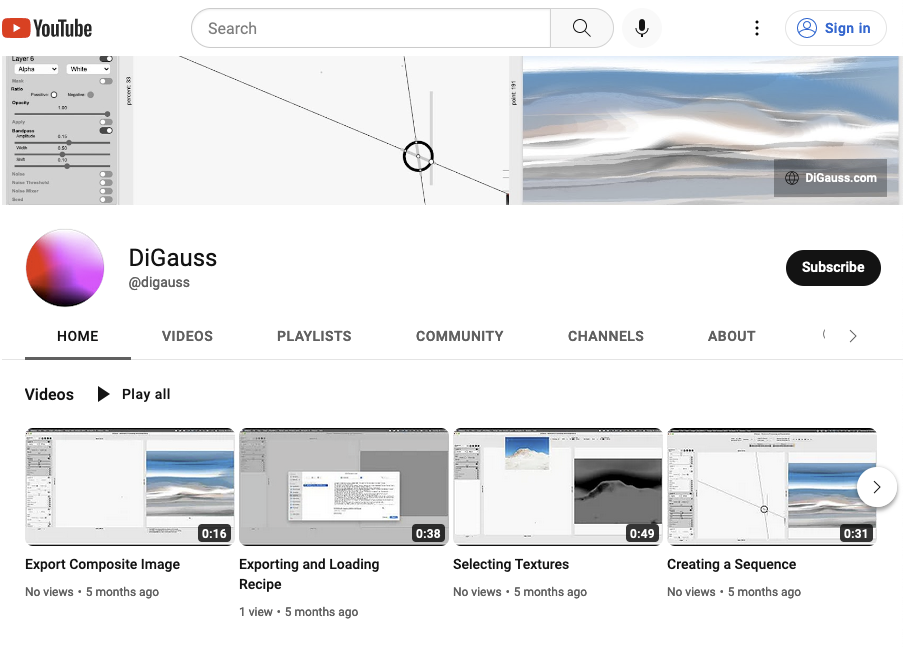Software created for image manipulation and sequencing.
Inspired by the way musicians employ modular synthesizers to generate layered sounds. DiGauss gives the user the ability to explore an image’s frequency space by layering an isolated range of frequencies, selecting from them, and recomposing the filtered output.
Developed and created by Robert Massman. Inspired by music created for images. support@digauss.com
Don’t feel like you need to keep reading
A little more detail
Initially based on the ideas regarding abstraction discussed in Rudolf Arnheim’s book “Visual Thinking”. Rudolf proposes the question "At what point does an image become an abstract representation of the thing it once was and at what point is it no longer perceived to represent that initial perception or representation." I liked this question especially in the framework of how it relates to children and their brains development from a young age. I remember as a young child laying in bed at night. Before drifting into sleep, on the wall, was a small quilt constructed with geometric patchwork of patterns and shapes. I would lay in bed and trace my eyes around those shapes trying to find patterns that weren’t immediately evident. I believe the simple visual game I played as a child created a tendency for my brain to gravitate towards geometric shapes trying to find structure where structure might not evidently exist. These two ideas have played heavily in my exploration of photography and the visual world.
Based on these thoughts I began to explore and manipulate images using Photoshop and Premiere Pro in much the same way an electronic musician explores and manipulates sound with a synthesizer and its modular components. Light and sound are both waves and at a fundamental level, the equipment, tools, and mathematics that have been created to capture, analyze and manipulate these waves are very similar if not the same. Inspired by this idea, I decided to see how I could use photoshop and its filters to reduce a still image into its component parts. Creating multiple plates with isolated image data. I then used photoshop to combine those plates and run them through another set of filters in order to extract different kinds of information.
An electronic musician can manipulate or create new sound using a synthesizer and its modular components and filters like LFO, High-pass, Low-pass, Envelope Generator and Gain. The access they have to the manipulation of these components has been kept on the surface and most often requires the musician to choose how they want to link the different components together. Photoshop is a lot like a synthesizer in many ways, it has High-pass and Low-pass filters, but it was not built to work like a synthesizer. Many of these manipulations are hard to get at, requiring many steps, and once achieved are permanent.
I’ve since become impassioned to build a web-based application in Chromium that allows for an image to be responsively manipulated and for it to draw inspiration from modular synthesizers musicians have used to manipulate sound.
A lot more probably un-needed details.
Time Line
Inspiration for creating my Chromium app came in 2015 after watching a few documentary films on the history of synthesizers. I began to explore the idea of how I could manipulate images by isolating their frequencies using Photoshop in much the same way an electronic musician explores and manipulates sound with a synthesizer and its modular components. I first tested my ideas by hand and then researched how I could use Photoshop's ExtendScript Toolkit to create a simple UI for making my image manipulation process more dynamic.
This is an image of the Adobe Photoshop UI I created using the ExtendScript Toolkit
While creating the ExtendScript Toolkit script for photoshop in 2017 I realized that the process I had been developing could be used to speed up tedious retouching of textures. For several fashion shoots that I was commissioned to work on I experimented with how my process could be used to isolate specific image frequencies and then minimize their visual appearance. Below are some of those results showing how specific frequencies can be isolated and minimized.
Left side: after Right side: before
Left side: after Right side: before
An early UI from 2017-2018
In 2018 wanting a more dynamic and unique UI than Photoshop would allow, I began to implement my image processing techniques within a webpage using HTML and JavaScript. I quickly realized I needed to take advantage of the GPU. Having no knowledge of how to write code for the GPU I sought help. I was able to find a programmer in Poland who for a price converted my image processing code, written for JavaScript, into code that could be run on the GPU. I then began to explore the artistic side of my image processing technique. See the images below.
Early image created by my webpage implementation
Early image created by my webpage implementation
In 2019 I felt I needed to push the commercial side of my image processing technique. I re-engaged the programmer I had previously hired. I asked him to help me refine the image processing algorithm. To inspire him I provided a few research papers I'd found and highlighted the ideas within them that I felt would be beneficial ideas to pursue. After a year of work implementing my ideas, I reached the limits of my budget and paused the commercial aspect of the app. I've since been refining my program into a chromium app. Please see below.
Image of RPM.app UI
In 2022 I settled on a name for the software calling it DiGuass. I then began the creation of this website www.digauss.com , Instagram and YouTube channel.
In late 2022. I created version 1.2.0 of DiGauss. The software is now signed with my apple developer ID and notarized by apple. Allowing for it to be run on a computer using macOS operating system.
DiGauss
v1.2.0
Publicly released on January 1, 2023.











